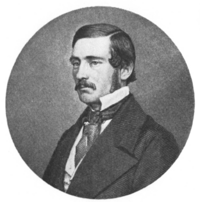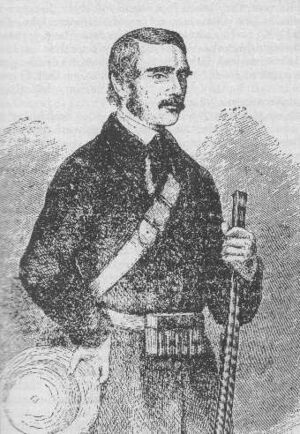Charles John Andersson facts for kids
Quick facts for kids
Charles John Andersson
|
|
|---|---|
 |
|
| Born | 4 March 1827 |
| Died | 9 July 1867 (aged 40) Omutwe-Onjambu, Angola
|
| Occupation | Trader, hunter, explorer |
Charles John Andersson (born Karl Johan Andersson) was a Swedish explorer, hunter, and trader. He was also very interested in nature and birds. He was born on March 4, 1827, in Värmland, Sweden. He passed away on July 9, 1867, in Angola.
Andersson is well-known for the many books he wrote about his journeys. He was one of the most important explorers of southern Africa, especially in the country we now call Namibia.
About Charles John Andersson
His Early Life
Charles John Andersson was born in Sweden in 1827. His father was Llewellyn Lloyd, a British bear hunter. His mother was a Swedish servant who worked for Lloyd.
Charles grew up in Sweden. From a young age, he went on hunting trips with his father. He learned a lot about Swedish nature. He also started collecting different types of plants and animals. In 1847, he began studying at the University of Lund.
Amazing Journeys
In 1849, Andersson traveled to London, England. He hoped to sell his collection of nature items. He wanted to earn money for trips around the world. In London, he met another explorer named Francis Galton. Together, they planned a trip to Southern Africa.
They arrived at the Cape of Good Hope in 1850. Then, they traveled to Walvis Bay, which is in modern-day Namibia. From there, they went deep into the land. Few Europeans had explored this area before. They wanted to reach Lake Ngami, but they did not succeed on that trip.
Galton went back to England, but Andersson stayed. He finally reached Lake Ngami in 1853. In 1855, he returned to London. There, he published his book called "Lake Ngami". This book described all his adventures. He went back to Africa in the same year.
Back in southwest Africa, Andersson worked as a manager for mines. These mines were in areas called Damaraland and Namaqualand. But he did not stay in that job for long. He soon continued his explorations. In 1859, he reached the Okavango River. He wrote another book about this trip, called The Okavango River.
After this journey, he traveled to the Cape. There, he got married. Andersson and his wife made their home in Otjimbingwe. This town is in central Namibia today.
Andersson often had money problems. Even though he loved exploring and studying nature, he had to earn money. He did this by trading and hunting. He did not have enough money to publish his books. Even his friend Galton would not lend him money.
His Final Journey
In 1867, Andersson became very sick. Despite his illness, he traveled north. He wanted to reach the Portuguese settlements in modern Angola. His goal was to find a better trading route to Europe.
He tried to cross the Cunene River, but he could not. He had to turn back. His health got much worse during this journey. On his way back, he passed away on July 9, 1867. Another Swede, Axel Wilhelm Eriksson, buried him.
After his death, Andersson's wife and children stayed in Africa. They lived in the Cape Colony. His father later published some of his notes. These notes became a book called "Notes of Travel in South-Western Africa".
See also
 In Spanish: Karl Johan Andersson para niños
In Spanish: Karl Johan Andersson para niños


